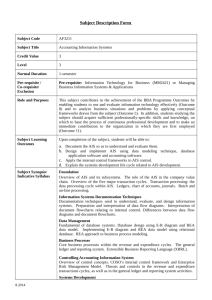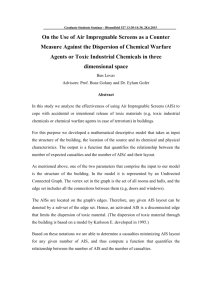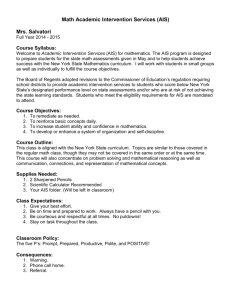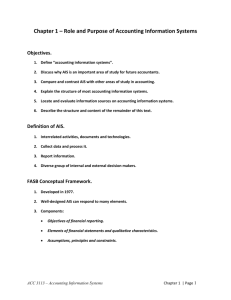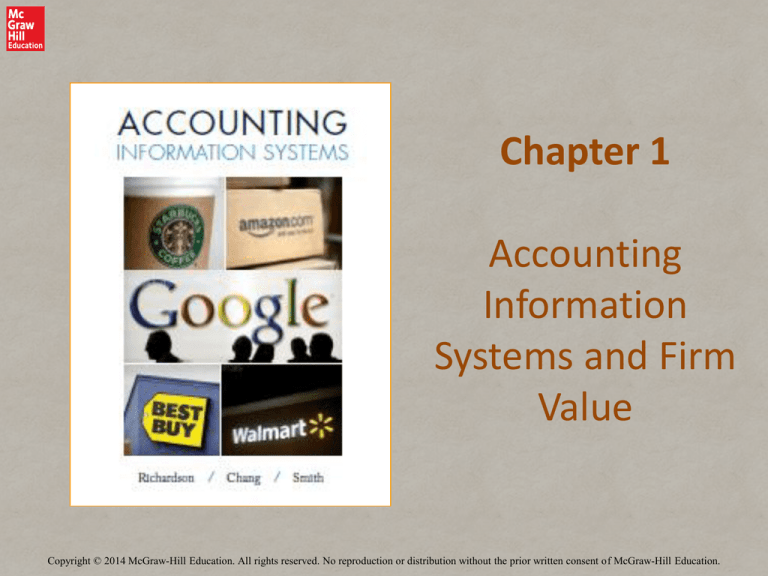
Chapter 1
Accounting
Information
Systems and Firm
Value
Copyright © 2014 McGraw-Hill Education. All rights reserved. No reproduction or distribution without the prior written consent of McGraw-Hill Education.
Learning Objectives
• LO#1 Define an accounting information system and explain
characteristics of useful information.
• LO#2 Distinguish among data, information and an information
system.
• LO#3 Distinguish the roles of accountants in providing information
and explain certifications related to accounting information systems.
• LO#4 Describe how business processes affect the firm’s value
chain.
• LO#5 Explain how AIS affects firm value.
• LO#6 Describe how AIS assists the firm’s internal business
processes.
• LO#7 Assess how AIS facilitates the firm’s external business
processes.
• LO#8 Assess the impact of AIS on firm profitability and stock prices.
1-2
LO# 1
Accountants as Business Analysts
• Increasingly, the role of an accountant is to
help address business opportunities.
• To address such a business opportunity, the
accountants need to decide what information
is needed, then build an information system to
gather the necessary information and finally
analyze that information to offer helpful
advice to management.
1-3
LO# 1
Accounting Information Systems
• An accounting information system (AIS) is defined as a
system that records, processes and reports on
transactions to provide financial and non-financial
information to make decisions and have appropriate
levels of internal controls (security measures to protect
sensitive data) for those transactions.
• An AIS is important because it provides information
that companies are required to have and also
information that can be used to make important
decisions.
1-4
LO# 1
Why Study AIS?
• It’s fundamental to accounting.
– Accounting is an information providing activity, so
accountants need to understand:
• How the system that provides that information is design,
implemented, and used
• How financial information is reported
• How information is used to make decisions
1-5
LO# 1
What Can an AIS Do?
• Imagine Starbucks’ system, which can track a
variety of things.
– The number of hours worked by employees all over
the world.
– The amount of sales taxes to be paid by one store.
• Wal-Mart has an extensive information
system.
1-6
LO# 1
A Simple Information System
Possible Input: Sales at Starbucks
Possible Storage: Database of all Sales at Starbucks
Possible Processing: Queries of What Sells Best at Night
Possible Output: Reports of What Sells Best at Night
1-7
LO# 1
Attributes of Useful Information
• To be useful information must have these
attributes:
– Relevant – information that is capable of making a
difference in a decision
• Predictive Value
• Feedback Value
• Timely
– Reliable – information that is free from bias and error
• Verifiable
• Representational Faithfulness
• Neutrality
1-8
LO# 2
Data vs. Information
• Data are simply raw facts that describe an event and have
little meaning on their own.
• Information is defined as being data organized in a
meaningful way to be useful to the user. Data serves as an
input.
• For example, the sales prices of a particularly toy might be
considered data. However, after subtracting the cost of
goods sold from the sales price to compute the net profit
would be considered information if it helps a retailer decide
whether to carry that particular toy in its inventory.
1-9
LO# 2
Information Overload
• Computers can process and organize a
large amount of data.
• Too much information causes information
overload.
– Decision making is hindered.
1-10
LO# 1
Information Value Chain
1-11
LO# 2
Discretionary versus Mandatory Information
• Discretionary information is information that
is not required by law.
– Using an ABC system to determine the overheads
costs associated with each pound of chicken at Tyson
Foods.
– Managers must decide if the benefits of discretionary
information outweigh the costs of obtaining it.
1-12
LO# 2
Discretionary versus Mandatory Information
• Mandatory information is information that is
required by law.
– Examples include: Form 10-K (Annual Reports that
include Financial Statements) and Tax Returns
• See SEC EDGAR for examples of required annual reports
for public companies.
– Since it is required manager usually choose to
minimize the costs of producing this information.
1-13
Role of Accountants in AISs
LO# 3
• Designer
– System Analyst
• Implementer
– Database Administrator
• User
– Recording Journal Entries
• Evaluator
– Auditor
• Manager
– Controller or CFO
1-14
LO# 3
Certifications in AIS
• Certified Information Systems Auditor (CISA)
– Perform IT Audits
• Certified Information Technology Professional
(CITP)
– Work to effectively and efficiently manage
information while ensuring the data’s reliability,
security, accessibility and relevance.
• Certified Internal Auditor
– Globally accepted certification for internal auditors
1-15
LO# 4
Value Chain
1-16
Where do AIS add value to a Business? In the
Primary Activities?
LO# 4
• Inbound logistics are the activities associated with receiving and
storing raw materials and other partially completed materials, and
distributing those materials to manufacturing when and where they
are needed.
• Operations are the activities that transform inputs into finished
goods and services (e.g. turning wood into furniture for a furniture
manufacturer; building a house for a home builder).
• Outbound logistics are the activities that warehouse and distribute
the finished goods to the customers.
• Marketing and sales activities identify the needs and wants of their
customers to help attract them to the firm’s products and buy
them.
• Service activities provide the support of customers after the
products and services are sold to them (e.g. warranty repairs, parts,
instruction manuals, etc.).
1-17
Where do AIS add value to a Business? In the
Support Activities?
LO# 5
• Firm infrastructure activities are all of the activities needed
to support the firm, including the CEO, finance, accounting,
and legal.
• Human resource management activities include recruiting,
hiring, training and compensating employees.
• Technology activities include all of the technologies to
support value-creating activities. These technologies also
include research and development to develop new
products or research and development to determine ways
to produce products at a cheaper price.
• Procurement activities involve purchasing inputs such as
raw materials, supplies, and equipment.
1-18
LO# 6
AIS and Internal Business Processes
• AIS usually serve as the as the foundation for the
enterprise (or ERP) system.
• The enterprise system is a centralized database
that collects data from throughout the company
including orders, customers, sales, inventory, and
employees.
• Information is thus available to everyone within
the company in a useful and timely way.
1-19
LO# 6
Use of ERP System
• The enterprise system can take an order from
a customer, fill the order, ship it, and then
create an invoice to bill the customer.
– Used to check customers credit.
– Check the inventory levels in the warehouse.
– Determine when it can be shipped.
• Everyone throughout the entire process can
view and update the information.
1-20
LO# 7
Figure 1.6 AIS and External Business Processes
1-21
LO# 7
The Supply Chain
• The supply chain refers to the flow of
materials, information, payments, and
services from suppliers all the way through
the customer.
• There are many processes involved which
can be made more efficient using the AIS.
1-22
LO# 7
Supply Chain Management
• Supply Chain Management software can
be used to optimize processes within the
supply chain.
– Determine levels of inventory in stock and to be
ordered.
– Determine timing to transferring inventory.
1-23
LO# 7
Customer Relationship Management
• This software is used to manage
interactions with customers.
– Track customer purchases.
– Ensure customer satisfaction.
– Product placement
1-24
LO# 7
Customer Relationship Management
• As an example, Amazon.com keeps a record of
their past purchases and product searches and
then uses that information to recommend other
similar products for the customer to consider.
• Loan officers at a bank learns more about the
financial products currently being used by its
bank’s customers through its AIS, they will be
able to help identify additional bank products
(upselling items such as insurance products, CD’s,
mutual funds, etc.) to sell to their clients.
1-25
LO# 7
The Effect of AIS on the Income Statement
1-26
LO# 8
AIS, Firm Profitability, and Stock Prices
• As show on the previous slide, AIS can be
used to improve company profits.
• In addition, studies show that investments
in IT can positively affect a company’s
stock price.
1-27
LO# 8
Summary
• An accounting information system (AIS) is defined as being an
information system that records, processes and reports on
transactions to provide financial information for decision making
and control.
• Firms invest in accounting information systems to create value. The
value chain illustrates how during each primary activity, the product
should gain some value. An AIS serves an important role in
enabling value in each primary and supporting activity.
• An AIS creates value by managing internal and external business
processes such as enterprise systems, supply chain management
and customer relationship management software.
• An AIS system generally helps make business processes more
efficient and effective. A well-designed and well-functioning AIS
can be expected to create value by increasing revenues and
reducing expenses.
1-28





